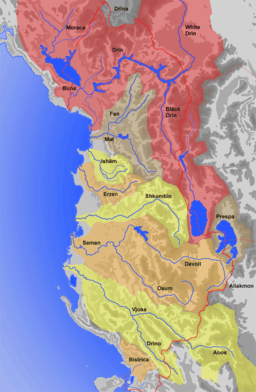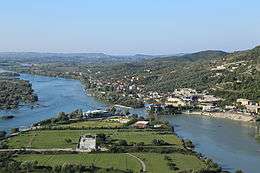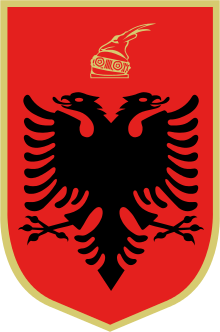Drin (river)
| Drin | |
| Drini | |
| River | |
 Drin river delta | |
| Country | Macedonia, Kosovo and Albania |
|---|---|
| Source | confluence of White Drin and Black Drin |
| - location | Kukës |
| - coordinates | 42°04′N 20°25′E / 42.067°N 20.417°E |
| Mouth | Adriatic Sea |
| - coordinates | 41°45′2″N 19°34′19″E / 41.75056°N 19.57194°ECoordinates: 41°45′2″N 19°34′19″E / 41.75056°N 19.57194°E |
| Length | 335 km (208 mi) |
 Drin is located in northern Albania | |
The Drin (Albanian: Drin or Drini; Macedonian: Дрим; Greek: Δρίνος) is the longest river in Albania with a total length of 335 km (208 mi) of which 285 km (177 mi) flows within Albania proper.[1][2] It has two distributaries, one going directly into the Adriatic Sea, the other one into the Bojana River (Buna in Albanian).
Origin
The Drin starts at the confluence of its two headwaters, the Black Drin in the city of Struga Republic of Macedonia, and the White Drin in the city of Kukës in the Trektan area of eastern Albania. Measured from there until its end at the Adriatic sea, the Drin is 160 km (99 mi) long. However, measured from the source of White Drin, its length is 335 km (208 mi), making it the longest river that runs through Albania.[2] The Black Drin (Drini i Zi in Albanian; Crn Drim in Macedonian) flows out from the Lake Ohrid in Struga and runs through the Republic of Macedonia and Albania. The White Drin (Drini i Bardhë in Albanian; Beli Drim, Cyr. Бели Дрим, in Serbian) originates from the Zhleb mountain, north of the town of Peja in the Dukagjin region of Kosovo,[lower-alpha 1] and runs from there through to Albania.[3]
Course
From Kukës, the Drin flows through northern Albania, first flowing through the Has area to the north, passing through the towns of Spas, Msi and Fierzë, and then, upon reaching the Dukagjini area, it descends to the south, flowing through Apripë e Gurit, Toplanë, Dushman, Koman, Vjerdhë Mazrrek, Rragam, and Pale Lalej. At Vau i Dejës, it enters the low Shkodra Field and splits into two arms. One empties into the Bay of Drin (Albanian: Pellg i Drinit) into the Adriatic Sea southwest of the city of Lezhë (The Mouth of Drin, Albanian: Gryk' e Drinit). The other empties into the Bojana River near the Rozafa Castle. Even though being a shorter branch by 15 km, the section that reaches the Bojana is called Great Drin (Drini i Madh in Albanian), because it brings much more water than the longer branch which reaches the sea. The Great Drin also once reached the sea but a major flood in 1858 cut it short from the sea, and breached through to the Bojana. The Great Drin is very wide and brings a huge amount of water (320 m³/s), but being short, some maps indicate it as a lake. After Vau i Dejës, the longer branch continues to the south, passing through Bushat, Mabë, Gjadër, Lezhë and Medes. South of Lezhë it enters the low and flooded littoral area and flowing through the marshes it finally reaches the Adriatic.
Economy
The Drin is extremely important for the Albanian economy, especially for its electrical production. Four hydropower facilities produce most of Albania's electricity (over 1200MW capacity). The artificial Lake Fierza (Albanian: Liqeni i Fierzës) created by the dam at Fierzë is the largest artificial lake in Albania with its surface of 73 km². The second largest artificial lake is also built on this river. Vau i Dejës lake (Albanian: Liqeni i Vaut të Dejës) has an area of 25 km². Construction of the Fierza power station caused some controversy in the 1980s. Without reaching any agreement, the Albanian government ordered the reservoir to be filled with water, which flooded some border areas of Kosovo, then part of Yugoslavia. The Yugoslav government protested, but no solution was agreed on. Thus, today, Lake Fierza is shared by Albania and Kosovo.
Wildlife

The Drin and its surrounding mountainous areas have a great variety of flora and fauna. Recently many fish species have been introduced such as the zander (pike-perch) of northern Europe which is a predator of the native fish population.
Notes and references
Notes:
- Mala Prosvetina Enciklopedija, Third edition (1985); Prosveta; ISBN 86-07-00001-2
- Jovan Đ. Marković (1990): Enciklopedijski geografski leksikon Jugoslavije; Svjetlost-Sarajevo; ISBN 86-01-02651-6
- ↑ Kosovo is the subject of a territorial dispute between the Republic of Kosovo and the Republic of Serbia. The Republic of Kosovo unilaterally declared independence on 17 February 2008, but Serbia continues to claim it as part of its own sovereign territory. The two governments began to normalise relations in 2013, as part of the Brussels Agreement. Kosovo has received recognition as an independent state from 110 out of 193 United Nations member states.
References:
- ↑ Drin river sub-basin
- 1 2 Tom Streissguth (2011). Albania in Pictures. Twenty-First Century Books. p. 12. ISBN 978-0-7613-6378-1. Retrieved 26 September 2013.
- ↑ Klement Tockner; Urs Uehlinger; Christopher T. Robinson (31 January 2009). Rivers of Europe. Academic Press. p. 1156. ISBN 978-0-08-091908-9. Retrieved 26 September 2013.
See also
| Wikimedia Commons has media related to River Drin. |
